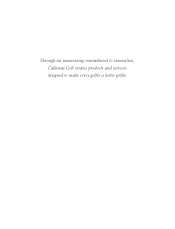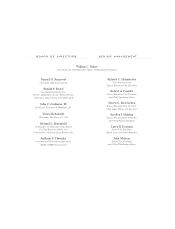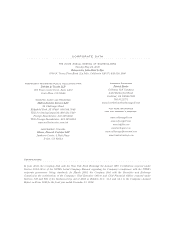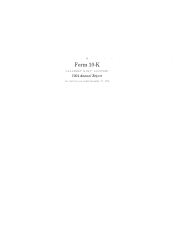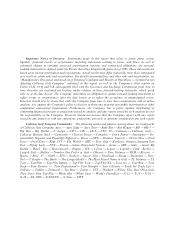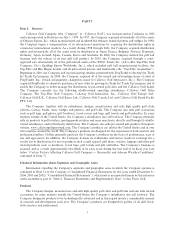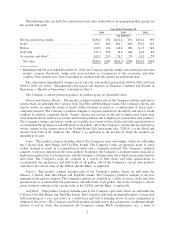Callaway 2004 Annual Report Download - page 13
Download and view the complete annual report
Please find page 13 of the 2004 Callaway annual report below. You can navigate through the pages in the report by either clicking on the pages listed below, or by using the keyword search tool below to find specific information within the annual report.Sales and Marketing
Sales in the United States
Approximately 58%, 55% and 55% of the Company's net sales were derived from sales for distribution
within the United States in 2004, 2003 and 2002, respectively. The Company primarily sells to both on- and
oÅ-course golf retailers and sporting goods retailers who sell quality golf products and provide a level of
customer service appropriate for the sale of such products. The Company also sells to mass merchants,
primarily with regard to its Top-Flite branded products. On a consolidated basis, no one customer that
distributes golf clubs or balls in the United States accounted for more than 4% of the Company's revenues in
2004, 2003 or 2002. On a segment basis, the golf ball customer base is much more concentrated than the golf
club customer base. In 2004, the top Ñve golf ball customers accounted for approximately 25% of the total golf
ball sales. A loss of one or more of these customers could have a signiÑcant adverse eÅect upon the Company's
golf ball sales.
Sales of the Callaway Golf and Odyssey branded golf clubs, golf balls and accessories in the United
States are made and supported by full-time regional Ñeld representatives and in-house sales and customer
service representatives who are employees of the Company. The Company maintains a separate sales force for
the sale of Top-Flite and Ben Hogan branded products. Like Callaway Golf, the Top-Flite and Ben Hogan
golf club, golf ball and accessory sales in the United States are sold and supported by full-time regional Ñeld
representatives and in-house sales and customer service representatives. However, the regional Ñeld represent-
atives that sell and support the Top-Flite and Ben Hogan branded products are independent contractors and
are permitted to sell the golf products of other companies, so long as such products do not compete with the
Top-Flite and Ben Hogan branded golf products.
Each geographic territory is covered by both a Ñeld representative and a dedicated in-house sales
representative who work together to initiate and maintain relationships with customers through frequent
telephone calls and in-person visits. The Company believes that this tandem approach of utilizing Ñeld
representatives and dedicated in-house sales representatives provides the Company a competitive advantage.
In addition to these sales representatives, the Company also has dedicated in-house customer service
representatives.
In addition, other dedicated sales representatives service corporate customers who want their corporate
logo imprinted on the Company's golf balls, putters or golf bags. The Company imprints the logos on its
products, thereby retaining control over the quality of the process and Ñnal product. The Company also pays
an agency fee to certain on- and oÅ-course professionals and retailers with whom it has a relationship for
corporate sales that originate through such professionals and retailers.
The Company also has a separate team of manufacturing and customer service representatives who focus
on the Company's custom club sales. Custom club sales are generated primarily from a club Ñtting experience
designed by the Company for golfers of all abilities. Club Ñttings are performed by golf professionals who are
speciÑcally trained to utilize the Company's proprietary club Ñtting software. The Company believes that
oÅering golfers the opportunity to gain knowledge of custom club speciÑcations increases sales and promotes
brand loyalty.
The Company maintains various sales programs from time to time including a Preferred Retailer
Program. The Preferred Retailer Program oÅers longer payment terms, as well as potential rebates and
discounts, for participating retailers in exchange for providing certain beneÑts to the Company, including the
maintenance of agreed upon inventory levels, prime product placement and retailer staÅ training.
Sales Outside of the United States
Approximately 42%, 45% and 45% of the Company's net sales were derived from sales for distribution
outside of the United States in 2004, 2003 and 2002, respectively. The Company does business (either directly
or through its subsidiaries and distributors) in more than 100 countries around the world. The Company's
management believes that controlling the distribution of its products in certain major markets in the world has
been and will continue to be an important element in the future growth and success of the Company.
4


